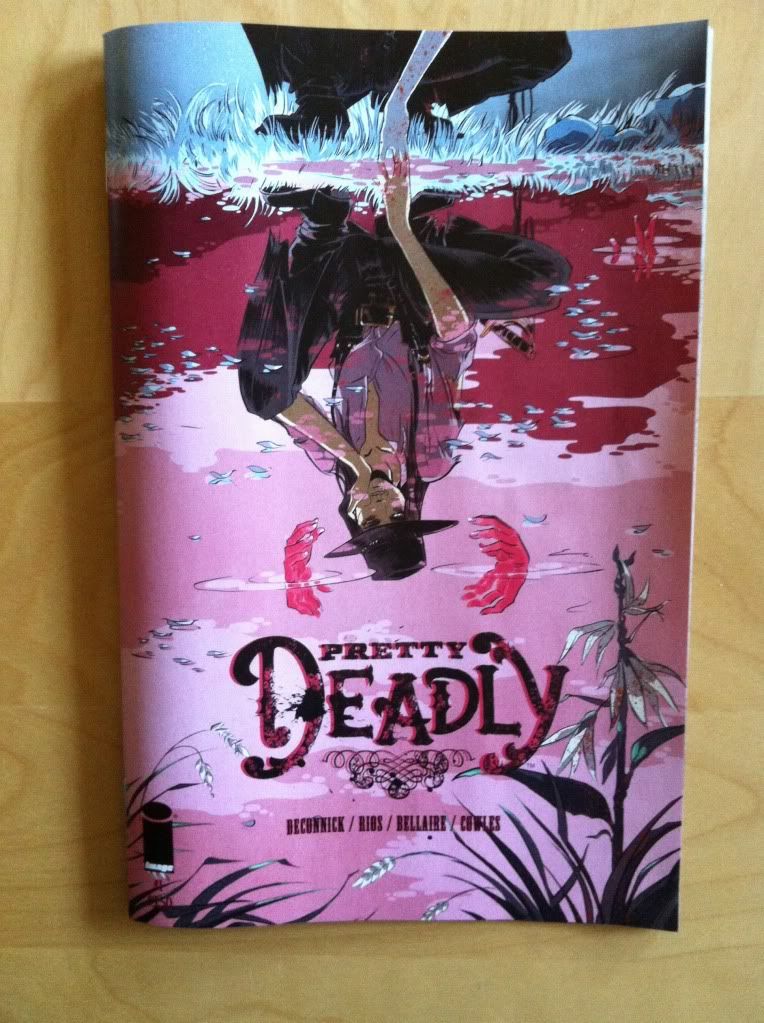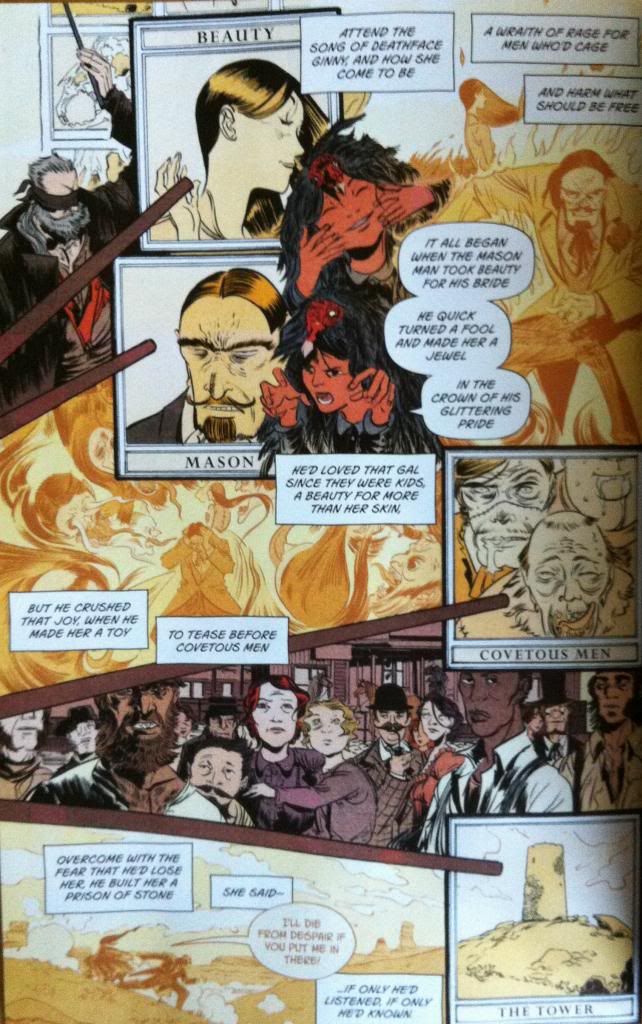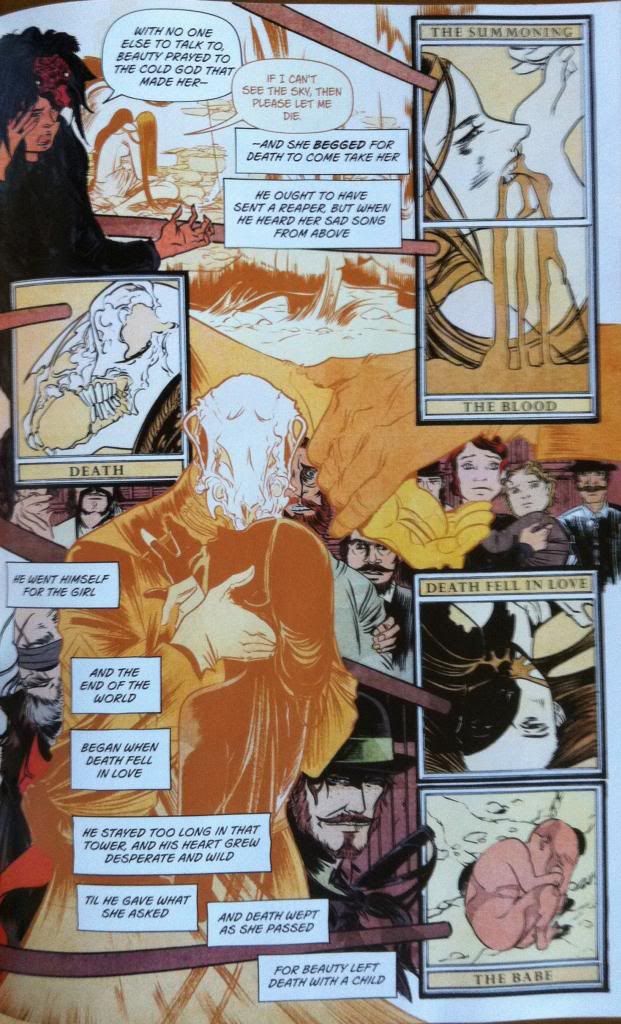By Kelly Sue DeConnick, Emma Rios, Jordie Bellaire, and Clayton Cowles
When I first picked up Pretty Deadly #1 I was struck at once by how good a comic it was and how ambitiously unconventional its approach to storytelling is. After a week of chewing away at it, I think that I may have missed something worth looking at a little closer, because the more I think about it, the more The Song of Deathface Ginny strikes me as a really great, really noteworthy bit of comics.
There will of course be *SPOILERS* for Pretty Deadly #1 within. You have been warned.
From a purely functional, this-is-how-a-story-works-logistically perspective, The Song of Deathface Ginny is pretty great. By introducing Ginny and her origins in this manner, Team Deadly manages to convey a surprising amount of information pertinent to the ongoing story in a really efficient way. The performance of the legend is conducted upon the gallows of a frontier town which instantly conveys that this comic is a period western and that death and a certain degree of lawlessness (enough to require a gallows in the town square) are endemic to the setting. By having the The Song of Deathface Ginny performed by Sissy, the vulture-cloaked girl, and Fox, the blind old man, we get to learn about these characters. We learn that Sissy is clever and charismatic and playful and the fox is solid and quiet and capable despite his lack of vision. We get to see how these two characters relate to one another and get some idea of their relationship and position in life. This approach to introducing Ginny also goes a long way to cementing her as a BIG deal, a force of such significance that travelling storytellers spread her tale and crowds gather to hear it. It also opens up a beautiful space of ambiguity to Ginny's backstory, a mythic uncertainty that gives her a certain enigmatic cache and maybe a place for the story to grow. If nothing else, The Song of Deathface Ginny is a really smart storytelling choice.
But it's so, so much more.
For one it is an actual performable piece of art written into a comic. The Song of Deathface Ginny is a thing you can sing/perform and people on the internet are already doing this. More than that though, the comic has a blueprint for how to do the larger performance: the words, how to make the chart, the costumes (vulture cloak, blindfold), and the stage direction needed to perform The Song of Deathface Ginny on your very own gallows or stage. I strongly suspect that we are living in the narrow times before live performances of the song erupt onto the internet and become a staple of conventions. And the fact that this bit of actual, stageable drama is inside of a comic is very cool.
The thing is though, The Song of Deathface Ginny goes beyond being merely a song or play. I would argue that it is also a kind of comic. As various wise comics sages have said, a comic is just words and pictures and you can tell any kind of story using words and pictures. Implicit in that idea is pictures and words which have a united narrative sequence (this picture and phrase comes before this next picture and phrase) and that the words are written into the comic as prose. BUT! The Song of Deathface Ginny, despite a lack of written words, has the formative elements of a comic. It has pictures in a story chart which provide a sequence of events and which, even without accompanying words, provide the general shape of the story. (It even moves top left to bottom right like a comics page.) Furthermore, these pictures have accompanying words, which are tied to individual images by the tap of the staff. Words coupled to pictures with a given sequence and progression. In essence, The Song of Deathface Ginny is a performable version of a simple comic book, which in the context of Pretty Deadly's setting, is a comic book for illiterate people. (The fact the words of The Song of Deathface Ginny have rhyme and meter makes them more memorable and is also indicative of an oral story meant to be distributed among an illiterate audience.) And this concept of a comic for the illiterate, and different forms a comic might take, kind of blows my mind.
Sort of tied to this idea of a comic as a performable, oral thing is this interesting idea that comics are tied to a tradition of theatre. I feel like I often encounter two conflicting ideas about the nature of comics. One is that comics are comics and are completely their own distinct artform. Another common school seems to suggest that comics are part of this spectrum of media and sits kind of between the freedom of prose writing and the visual dynamism of film. What I think both of these trains of thought maybe miss is that theatre is inherently part of comics DNA. I mean, superhero comics were heavily influenced by circus performers, vaudeville acts, escape artists, and illusionists and that theatricality I think is a formative norm of modern comics. (I may have just finished reading Michael Chabon's The Amazing Adventures of Kavalier and Clay...) Moreover, collaborative comics (writer, artist, colourist) have a lot in common with the format of staging a play: a writer produces a script of dialogue with some degree of stage direction, the artist directs the comic to stage the actual play with all of the fine acting and set choices, and the colourist works as a set designer enhancing mood, and lighting, and adding to the production in a sort of behind the scenes way. Part of what makes The Song of Deathface Ginny, and really all of Pretty Deadly #1, so intriguing is it takes the theatrical aspects of comics and plays with them in a very explicit deliberate way.
(Incidentally, I spend a lot of time thinking about comics when I put together powerpoint slides for Science talks. I find thinking about talks as a progression of images tied to words helps with clarity, and people seem to respond pretty well to a comics-inspired approach of presentation.)
(I may also try to fashion a vulture-cloak before my next talk.)
The Song of Deathface Ginny still has yet another pretty magical aspect to it: it shows how audiences experience comics. Comics are about looking at a series of static pictures tied to words and extrapolating from them dynamic, living stories. This a process that requires a certain degree of imagination because even the best comics select only representative snapshots of broader action. It is up to the audience of these comics to essentially fill in the spaces between panels to bring the story to life. During The Song of Deathface Ginny Team Deadly show, between the borders of the staff touching images (which, how great a choice is that!), the townsfolk audience imagining the extrapolated story of Ginny. Therefore, Pretty Deadly #1 literally shows the experience of reading comics in this really elaborate, really beautiful way. It's the magic of comics explained using the magic of comics.
Pretty Deadly #1 with it's Song of Deathface Ginny contains drections to a performance which is an oral comic that is used to show how comics effect their audience. All of which is built so organically into the fabric of the comic that it feels like an effortless bit of storytelling. And if all of this doesn't kind of blow you away a bit, than maybe you are doing comics incorrectly. Because DAMN.
Previously:
Pretty Deadly #1 pt.1: Breaking Rules






Sounds like I should check this one out. I really like your blog and I also posted a comment on your Young Avengers # 10 review.
ReplyDeleteCheers.
I saw! Thanks for commenting.
DeleteIf you are into comics that are formally interesting and also wicked good stories I'd say Pretty Deadly is worth taking a look at (if issue 1 is any indication). David Aja and Matt Fraction's Hawkeye series is also very deliberately playing with the medium of a mainstream superhero comic in a really nifty way, and Kelly Sue DeConnick's Captain Marvel has some great story structure and thematic stuff going on too if you dig superhero comics that play with the genre a bit.
Oh, and if you like detailed criticism of comics,this (http://mercurialblonde.wordpress.com/2013/11/06/the-cages-of-pretty-deadly/) is a much better one than the one I wrote. I'm kind of picking through it today and am wicked jealous of it.